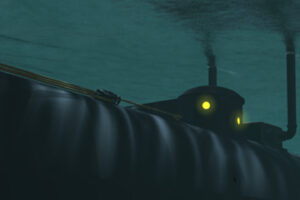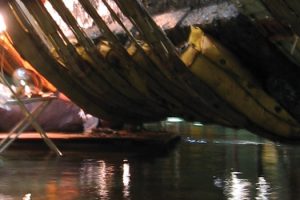Time itself is a multi-layered mystery to the international team of scientists working to excavate and conserve the world’s first successful military submarine.
On the day before the third anniversary of the raising of the H. L. Hunley from the floor of the Atlantic Ocean, researchers may be closer to answering questions that have puzzled historians for over a century: when exactly did the Hunley take on water?
The Rosetta stone that may help answer these questions is the ornate gold pocket watch that belonged to Hunley commander Lt. George Dixon, which was recovered during the excavation of the submarine on May 30, 2002. When the watch was opened earlier this year, Hunley scientists were hopeful the time on the watch would offer insight as to why the submarine mysteriously vanished after sinking the USS Housatonic on February 17, 1864.
As the scientists were soon to learn, however, there are many layers to the mystery of time.
Accounts from crewmembers aboard the Housatonic say the Hunley’s attack took place between 8:45 and 9:00 in the evening. When Lt. Dixon’s watch was opened earlier this year and the face displayed 8:23, more questions were raised than answered. After researching the operation of the watch and the time keeping standards of the day, Hunley scientists uncovered a series of fascinating clues.
During the Civil War, the Confederate States kept Local Apparent Solar Time as its standard, while United States naval vessels maintained the Local Mean Solar Time of Washington D.C.. These varying calculations, when adjusted, mean the time kept on Dixon’s pocket watch was probably 26 minutes behind the time kept onboard the Housatonic.
When scientists adjusted the time on the watch to the Local Mean Solar Time of Washington D.C., they came to the conclusion that Dixon’s watch stopped ticking at precisely 8:49. At first glace, such a time setting would appear to indicate the watch stopped within minutes of the Hunley’s attack on the Housatonic, suggesting the Hunley’s crew compartment flooded immediately after the attack. Drawing that conclusion at this moment, however, would be premature, according to Friends of the Hunley Chairman Warren Lasch.
“An important clue we will soon discover is whether or not the watch was completely wound down,” Lasch said. “To answer that question, experts will need to examine the watch’s internal mechanisms. And we still don’t know if the time is AM or PM or even the same day,” Lasch said.
The spring driven balance wheel used to power Dixon’s pocket watch cannot function underwater because the friction of the water stops the pendulum mechanism. Senator Glenn McConnell, Chairman of the Hunley Commission, is hopeful the watch will soon provide scientists with even more timely information.
McConnell said at this point the body of scientific evidence suggests that the Hunley crew compartment may not have immediately filled with water, a theory that could explain why most crewmembers were found at their stations.
“It is entirely possible that the Hunley’s crew compartment remained water tight long after the oxygen the crew needed to survive was gone. If the watch was protected for a time from the invasion of water, then it would have continued to tick until it gradually wound down,” McConnell said. The Hunley project team is currently working with watch experts to determine whether the watch had wound down, and once the research is completed, Lt. Dixon’s pocket watch may yet hold new clues to the mystery of the Hunley’s fate.
“If we lock in on the exact time, we lock in on the time sequence of her fate,” said McConnell.
“I continue to be awed by how much we’ve accomplished since the Hunley was recovered three years ago. This truly is a fantastic journey and a stirring tribute to the spirit of innovation that connects the past, the present and the future,” Lasch said.
The H. L. Hunley was located in 1995 by Clive Cussler”;s National Underwater Marine Agency (NUMA), a 501c3 non-profit organization. The hand-cranked submarine was raised on August 8, 2000 and delivered to the Warren Lasch Conservation Center, where scientists are at work excavating and conserving the historic vessel and its many artifacts.
For more information on the Hunley Project, log onto www.hunley.org. Hours of operation for public tours and the Hunley gift shop are from 10:00 a.m. to 5:00 p.m. on Saturdays and from noon to 5:00 p. m. on Sundays. All proceeds go to support the Hunley conservation and excavation project. To purchase tickets call toll free 1-877-4HUNLEY (1-877-448-6539) or log onto the Internet at www.etix.com.



